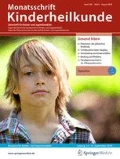Zusammenfassung
Somatoforme Störungen in der Kindheit können mit einer Vielzahl komorbider Erkrankungen einhergehen. Weniger (chronische) somatische Erkrankungen, sondern eher psychische Störungen, wie Angststörungen oder depressive Störungen, aber auch familiäre Belastungssituationen sowie schulische Probleme können das Risiko für das Auftreten somatoformer Störungen erhöhen. Die sorgfältige Anamnese, gezielte Exploration auf Lebensereignisse und konsiliarische kinder- und jugendpsychiatrische Untersuchung können bei der Identifikation sowohl der somatoformen Störung als auch komorbider Erkrankungen helfen. Gerade bei psychischen Erkrankungen, wie Angststörungen, Depressionen oder posttraumatischen Störungen, kann die störungsspezifische Therapie helfen, die somatoforme Symptomatik zu reduzieren.
Abstract
Somatoform disorders in childhood and adolescence are associated with a high variety of comorbid disorders. Some (chronic) somatic disorders cooccur with somatoform disorders less frequently but psychiatric disorders, such as anxiety disorder and depressive disorders are more frequent. Furthermore, domestic stress factors, such as divorce, victimization in school and school failure can increase the risk for somatoform disorders. Detailed assessment of the medical history, exploration of the risk situation and child and adolescent psychiatric examinations can help to identify both somatoform disorders and comorbid disorders. For most comorbid psychiatric disorders (e.g. depression, anxiety disorder) specific interventions for the comorbid disorder can help to reduce symptoms of somatoform disorders as well.

Literatur
Brähler E, Schumacher J (2002) Befund und Befinden: Psychologische Aspekte körperlicher Beschwerden, In: Brähler E, Strauß B (Hrsg) Handlungsfelder der psychosozialen Medizin. Hogrefe, Göttingen
Craig TK, Cox AD, Klein K (2002) Intergenerational transmission of somatization behaviour: a study of chronic somatizers and their children. Psychol Med 32(5):805–816
Craig TK, Bialas I, Hodson S, Cox AD (2004) Intergenerational transmission of somatization behaviour: 2. Observations of joint attention and bids for attention. Psychol Med 34(2):199–209
Erhart M, Weimann A, Bullinger M et al (2011) Psychische Komorbidität bei chronisch somatischen Erkrankungen im Kindes- und Jugendalter. Bundesgesundheitsblatt Gesundheitsforschung Gesundheitsschutz 54:66–74
Fritz GK, Fritsch S, Owen H (1997) Somatoform disorders in children and adolescents: a review of the past 10 years. J Am Acad Child Adolesc Psychiatry 36(10):1329–1338
Gehring S, Kullmer U (2012) Somatische Differenzialdiagnosen chronischer Bauchschmerzen. Monatsschr Kinderheilkd 1/2012
Goldbeck L, Freyberger HJ (2011) Somatoforme Störungen. In: Fegert JM, Streeck-Fischer A, Freyberger HF (Hrsg) Kompendium Adoleszenzpsychiatrie. Schattauer, Stuttgart New York
Huss M (2012) Depressionen im Kindes- und Jugendalter. Monatsschr Kinderheilkd 1/2012
Kerig PK, Ward RM, Vanderzoe KL, Arnzen Moeddel M (2009) Posttraumatic stress as a mediator of the relationship between trauma and mental health problems among juvenile delinquents. J Youth Adolesc 38(9):1214–1225
Ketola S, Niemensivu R, Henttonen A et al (2009) Somatoform disorders in vertiginous children and adolescents. Int J Pediatr Otorhinolaryngol 73(7):933–936
Kinzl JF, Traweger C, Biebl W (1995) Family background and sexual abuse associated with somatization. Psychother Psychosom 64:82–87
Lieb R, Pfister H, Mastaler M, Wittchen HU (2000) Somatoform syndromes and disorders in a representative population sample of adolescents and young adults: prevalence, comorbidity and impairments. Acta Psychiatr Scand 101(3):194–208
Lieb R, Zimmermann P, Friis RH et al (2002) The natural course of DSM-IV somatoform disorders and syndromes among adolescents and young adults: a prospective-longitudinal community study. Eur Psychiatry 17(6):321–331
Logan DE, Scharff L (2005) Relationships between family and parent characteristics and functional abilities in children with recurrent pain syndromes: an investigation of moderating effects on the pathway from pain to disability. J Pediatr Psychol 30:698–707
Lv X, Xi L, Han D, Zhang L (2010) Evaluation of the psychological status in seasonal allergic rhinitis patients. ORL J Otorhinolaryngol Relat Spec 72(2):84–90
Masi G, Favilla L, Millepiedi S, Mucci M (2000) Somatic symptoms in children and adolescents referred for emotional and behavioral disorders. Psychiatry 63(2):140–149
Nakazato M, Kodama K, Miyamoto S et al (2000) Psychiatric disorders in juvenile patients with insulin-dependent diabetes mellitus. Diabetes Res Clin Pract 48(3):177–183
Noeker M (2008) Funktionelle und somatoforme Störungen im Kindes- und Jugendalter. Hogrefe, Göttingen
Phillips KA (1996) Body dysmorphic disorder: diagnosis and treatement of imagined ugliness. J Clin Psychiatry 57:1–4
Schulte IE, Petermann F (2011) Familial risk factors for the development of somatoform symptoms and disorders in children and adolescents: a systematic review. Child Psychiatry Hum Dev 42(5):569–583. DOI 10.1007/s10578–011-0233-6
Schulte IE, Petermann F (2011) Somatoform disorders: 30 years of debat about criteria! What about children and adolescents? J Psychosom Res 70:218–228
Walker LS, Garber J, Greene JW (1991) Somatization symptoms in pediatric abdominal pain patients: relation to chronicity of abdominal pain and parent somatization. J Abnorm Child Psychol 19:379–394
Wasserman AL, Whitington PF, Rivara FP (1988) Psychogenic basis for abdominal pain in children and adolescents. J Am Acad Child Adolesc Psychiatry 27(2):179–184
Interessenkonflikt
Der korrespondierende Autor weist auf folgende Beziehungen hin:
Forschungsförderung durch BMBF, BMFFSJ, Schweizer Bundesamt für Justiz, Eli Lilly International Foundation, Boehringer Ingelheim und Europäische Akademie
Mitarbeit in klinischen Studien von Eli Lilly, Astra Zeneca, Janssen-Cilag
Reisebeihilfen/Vortragshonorare: Universität Rostock, DGKJPP, UCB, diverse gemeinnützige Organisationen
Keine Aktien, keine Beteiligungen an Pharmafirmen
Kein Konflikt erklärt
Author information
Authors and Affiliations
Corresponding author
Rights and permissions
About this article
Cite this article
Kölch, M. Komorbidität bei somatoformen Störungen im Kindes- und Jugendalter. Monatsschr Kinderheilkd 160, 27–31 (2012). https://doi.org/10.1007/s00112-011-2514-3
Published:
Issue Date:
DOI: https://doi.org/10.1007/s00112-011-2514-3

